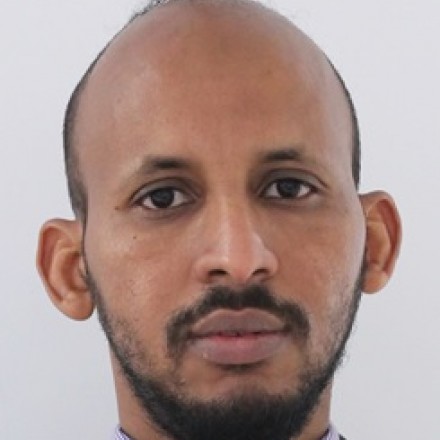Dr Ahmed Abdullahi Hashi

Contacts
Dr Ahmed Hashi is a Medical Radiation scholar; Ahmed’s publications involve exploring new techniques that improve disease detection while minimising the risk of radiation dose and contrast media to the patients. His publications have resulted in him being the recipient of a prestigious Australian Capital Territory Excellence Research Award in recognition of excellence in medical research and contribution to ACT public radiology departments for imaging pulmonary embolism and acute alternative respiratory diseases. Ahmed was previously a medical imaging supervisor and clinical educator for Canberra University medical imaging students.
Research interests
Low Dose CT for Pulmonary Embolism and Lung screening.
Abstract
CT pulmonary angiogram (CTPA) is utilised to diagnose pulmonary embolus in various clinical settings. CT imaging has considerable advantages over other imaging modalities. Whilst considering its widespread application and advantages, it tends to have high radiation exposure. Additionally, there are high rates of suboptimal and non-diagnostic examinations that result in unnecessary radiation dose. Therefore appropriate radiation dose reduction techniques are required without compromising imaging quality; unfortunately, efforts to reduce radiation dose can also diminish image quality and lead to missed pulmonary emboli and other lung pathologies.
Several studies have investigated 80kV CTPA protocols and found a considerable upsurge in image noise and reduced imaging quality. The purpose of this research project was to develop an 80kV CTPA protocol with reduced imaging noise, decreased radiation dose and simultaneously reducing suboptimal examinations in patients with suspected pulmonary embolism. Both qualitative and quantitative approaches were conducted to achieve this purpose.
This study has demonstrated that the new 80kV CTPA protocol can considerably reduce patient mean effective radiation dose by 66% with a mean radiation dose 1.005mSv compared to 3.03mSv with current 100kV protocols. The study has also demonstrated a reduced rate of suboptimal examinations and a significant increase in contrast enhancement of the pulmonary arterial tree. It has also found that a gentle breath-hold open
mouth technique with 80kV scanning protocol also improves imaging quality.
In terms of imaging quality assessment, the low dose CTPA protocol yielded acceptable image quality comparable to the standard protocol as per the radiologist assessment.
This study’s original contribution to knowledge is introducing a new low dose CTPA protocol that allows the imaging departments to achieve an excellent contrast enhancement and lower suboptimal examinations. This study’s overall significance is a demonstrable reduction in radiation dose without affecting the CTPA image quality in the majority of the patients.
- Hashi AA, CT Pulmonary Angiogram with Reduced Radiation Exposure at Low Tube Kilovoltage. Jurnal Profesi Medika: Jurnal Kedokteran dan Kesehatan. 2020 Dec 13;14(2).
- Hashi AA, Approaches to reduce the rate of suboptimal CT pulmonary angiograms. Jurnal Profesi Medika: Jurnal Kedokteran dan Kesehatan. 2020 Dec 14;14(2).
- Acute respiratory diseases and differential diagnosis of pulmonary embolism. Jurnal Profesi Medika: Jurnal Kedokteran dan Kesehatan.
- Optimised CT Pulmonary Angiogram Protocol in Pregnant Patients with Suspected Pulmonary Embolism. Jurnal Profesi Medika: Jurnal Kedokteran dan Kesehatan.
- Hashi AA, Optimising Radiation Dose of CT Pulmonary Angiogram for Imaging Pulmonary Embolism and Alternative Acute Respiratory Diseases, 2021
- Canberra University, Faculty of Medical Imaging 2018 – 2020.










